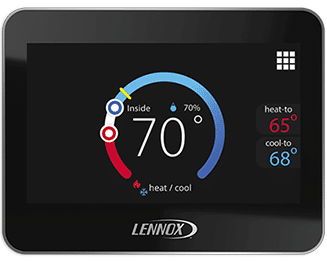Does My Thermostat’s Location Matter?

You use your thermostat to make sure your home is at a comfortable temperature. It’s more than just a switch or dial, though: thermostats read the temperature inside your house and use that to adjust your HVAC accordingly. Your thermostat’s location may prevent it from working properly, keeping your home too hot or too cold. Read on for information about where thermostats should go and why.
The Thermostat’s Job
First, consider the important job your thermostat performs for your HVAC system. Initially, it measures the temperature in the room. The theory is that the air around the thermostat is representative of the air around your home. If you have a digital thermostat, it’ll display the recorded temperature on the digital screen.
As it registers the air’s temperature, it’ll then send electrical signals to your HVAC system, telling it when to start and stop. If it’s not registering the temperature properly, it won’t signal your system at the right times. This leads to many areas of your home not achieving your desired temperature, and more frequent heating and cooling cycles.
Not registering a representative temperature doesn’t necessarily indicate a malfunctioning thermostat. Rather, it could be that your thermostat isn’t placed properly, with factors that may make it read either too hot or too cold.
Preferred Position in Your Home
There are several factors that make a particular placement for your thermostat ideal. Let’s start with the general location in terms of room in your home.
You want to locate the thermostat on an interior wall of your home. This prevents any unusual heat transfer between the outside wall and your thermostat.
If you’re using a single thermostat for the system, try to locate it as close to the center of your home as possible. This prevents it from only registering the temperature at the extremities of your home, leaving the center either too hot or cold.
Next, try to find a good place to locate the thermostat in a commonly used room in your home. With frequent use, the body heat from its occupants will affect the room’s ambient temperature. Using a common room ensures the spaces you spend the most time are comfortable.
Avoid placing your thermostat in hallways whenever possible. These generally have poor air circulation, plus you don’t spend a lot of time in these spaces, often leaving the occupied rooms uncomfortable.
Placement On the Wall
Now that you know which room to install your thermostat, let’s talk about where on the wall to place it. Yes, the location on the wall actually makes a big difference in how it registers the temperature.
It’s common knowledge that hot air rises while cool air sinks. For your home’s HVAC system, this is an important consideration in regulating the temperature. If your thermostat is too high, it’ll register warmer than what you experience. Likewise, if it’s too low, it’ll register cooler temperatures.
The ideal height for your thermostat is between 52 and 60 inches from the floor. This is about the height of the air that most adults will experience moving throughout the home. Additionally, it’s about mid-height for most standard rooms, which are about 108 inches tall.
Which Floor Should You Put It On?
If you live in a multi-story home, you may question where to place the thermostat. If it’s a traditional two-story home, put it on the first floor. For a split-level, put it on the floor that’s at ground level. However, if it’s a split-level where one floor is partially subterranean and the other floor is elevated, place the thermostat on the higher level.
The idea is to keep the thermostat on the level that is about mid-height for your home. Keep in mind, the same concept that affects where you place it on the wall also affects your floor choice. Be sure to discuss the placement with your HVAC professional to ensure the floor you install it on will offer the best regulation for your entire home.
Caution Near Windows and Doors
We’ve already discussed the caution of placing your thermostat on an exterior wall. However, windows pose another potential problem for registering an accurate temperature.
As you look at the interior walls available for your thermostat, consider how the sun shines in the room. If your thermostat is in direct sunlight, it’ll register a temperature that’s too high.
You can use shades and blinds to reduce the sun coming into the room. However, if you depend on those for your thermostat to register an accurate temperature, you’re limiting the use of your room. You’ll forego opening the windows while the sun shines through that window, reducing your natural lighting capabilities.
Similarly, avoid putting the thermostat near an exterior door. While you don’t have to worry about the sunlight coming in, you do need to consider drafts and temperature fluctuations when you come and go.
Be Conscious of HVAC Vents
Next, observe where your HVAC supply vents are located and where they’re pointing. Installing a thermostat close to a supply vent will cause it to register the temperature of the air coming from the vent, not the ambient air temperature. The result is your system shutting down prematurely, leaving your home uncomfortable, and increasing your utility costs.
Depending on the layout of your home and HVAC system, you may want to locate your thermostat near a cool air return. Some say this is preferable, being it’ll register the temperature of the air as it goes into the system. This will give you the truest sense of the ambient temperature in your home.
Consider Other Heat Sources
Another important consideration is how close you put your thermostat to other heat sources. Of particular consideration is your kitchen, which has significant heat sources at the stove, oven, and even dishwasher. Also, think about where your plumbing travels, and keep your thermostat away from areas of the wall that has hot water pipes running behind it. If you use a portable heater for one room, keep it away from your thermostat, or keep the door shut to prevent inaccurate readings.
Special Considerations for Smart Thermostats
Smart thermostats are an incredible addition to any home because of their ease of use. However, when deciding where to place them, you’ll need to keep them within range of your wireless router to take advantage of all of their features.
Thinking Through Zoned Systems
Homes benefit from zoned HVAC systems, which use multiple thermostats throughout the house and dampers in the ducts. This allows you to tightly control the temperature throughout your home, and ensure your system is only heating or cooling those areas needing it.
If you’re using this kind of system, you’ll want to consider the placement of each thermostat. Keep them all on interior walls, out of direct sunlight, and away from heat sources.
People around Seattle have turned to Brennan Heating & Air Conditioning to keep their homes comfortable since 1987. Our customers depend on our expert heating and cooling installation, maintenance and repair, together with our water heater and indoor air quality services. Call to schedule your service appointment with one of our friendly technicians at Brennan Heating & Air Conditioning today.







